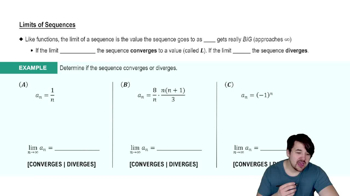Table of contents
- 0. Fundamental Concepts of Algebra3h 29m
- 1. Equations and Inequalities3h 27m
- 2. Graphs1h 43m
- 3. Functions & Graphs2h 17m
- 4. Polynomial Functions1h 54m
- 5. Rational Functions1h 23m
- 6. Exponential and Logarithmic Functions2h 28m
- 7. Measuring Angles40m
- 8. Trigonometric Functions on Right Triangles2h 5m
- 9. Unit Circle1h 19m
- 10. Graphing Trigonometric Functions1h 19m
- 11. Inverse Trigonometric Functions and Basic Trig Equations1h 41m
- 12. Trigonometric Identities 2h 34m
- 13. Non-Right Triangles1h 38m
- 14. Vectors2h 25m
- 15. Polar Equations2h 5m
- 16. Parametric Equations1h 6m
- 17. Graphing Complex Numbers1h 7m
- 18. Systems of Equations and Matrices3h 6m
- 19. Conic Sections2h 36m
- 20. Sequences, Series & Induction1h 15m
- 21. Combinatorics and Probability1h 45m
- 22. Limits & Continuity1h 49m
- 23. Intro to Derivatives & Area Under the Curve2h 9m
23. Intro to Derivatives & Area Under the Curve
Limits of Sequences
Struggling with Precalculus?
Join thousands of students who trust us to help them ace their exams!Watch the first videoMultiple Choice
Evaluate limn→−∞an and determine whether the sequence converges or diverges.
an=300sin(nn2−120)
A
an=300, converges.
B
an=300, diverges.
C
an=DNE, converges.
D
an=DNE, diverges.
 Verified step by step guidance
Verified step by step guidance1
First, identify the sequence given: a_n = 300\sin\left(\frac{n^2 - 120}{n}\right).
To evaluate the limit as n approaches negative infinity, consider the expression inside the sine function: \frac{n^2 - 120}{n}.
Simplify \frac{n^2 - 120}{n} to n - \frac{120}{n}. As n approaches negative infinity, \frac{120}{n} approaches 0, so the expression simplifies to n.
The sine function, \sin(n), oscillates between -1 and 1 for all real numbers n. Therefore, \sin(n) does not settle to a single value as n approaches negative infinity.
Since \sin(n) oscillates indefinitely, the sequence a_n = 300\sin(n) does not converge to a single value, and thus the limit does not exist (DNE), indicating divergence.
Related Videos
Related Practice




